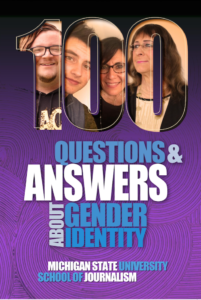This guide and glossary answer more than 100 questions for international students, workers and guests in the U.S. Here are 20. You can get all 100 questions by ordering a print or digital guide from Amazon.
Why do Americans speak English with many different accents?
How can I learn American slang?
What are appropriate ways to greet people in America?
When should I tip and how much should I leave?
Why is racism such an issue in America?
What is the meaning of “How’s it going?”
Why do so many Americans own guns?
What is included in a date?
People in the United States smile at strangers for no reason. Why is that and what is the meaning?
How much personal space should I maintain between myself and Americans when speaking to them or riding the bus?
What are American customs for eye contact?
In cafeterias, people seem to prefer sitting with people of their racial group. Do people of different races mix?
Americans seem to have many religions. What are the main ones?
How good is the U.S. health care system?
Why do you have to be 18 years old to buy cigarettes?
If marijuana is illegal, why do so many people smoke it?
Do Americans drink a lot of coffee?
Why are the meal portions so large?
Why do Americans eat unhealthy food?
Why do children have to do chores?
How common is divorce in America?
Why do Americans speak English with many different accents?
Because the United States is so large, there are many different regions. Often, people in one area speak English differently than those in another place. The ethnic composition, lifestyle, culture, and location of a region influence the way English is spoken there. The English language is made up of many words from other languages and countries. Back to Top | To order
How can I learn American slang?
American slang is not easy to learn. Slang is always changing and terms might not have obvious meanings. There guide is here to help you learn some of these terms and a couple of websites to help you keep up. Back to Top | To order
What are appropriate ways to greet people in the United States?
“Hello” or “How are you?” or “It’s nice to meet you,” often are enough. First-time acquaintances or individuals meeting in professional situations typically shake hands, and many females greet their friends with a hug. There are no widespread U.S. customs about males and females greeting, as there are in some cultures. Back to Top | To order
Tipping guidelines
Waiters in sit-down restaurants 15-20 percent
Food deliveries As above, $2 minimum
Baggage handler $1 per bag
Bartender $1-2 per drink
Car parker $1-2
Coat check $1 per coat if free
Coffee place with tip jar Optional
Grocery bagger None
Taxi/limo driver 10-15 percent
Bus driver None
Haircuts 15-20 percent
Hotel maid $1-2 per night
Do what you are comfortable with, and don’t feel obligated to leave a tip if you are dissatisfied with the service. Back to Top | To order
Why is racism such an issue in America?
The United States has a complicated racial and ethnic history. It includes slavery of Native Americans and Africans; genocide and removal of Native Americans; the annexation of parts of Mexico that now make up several western states; the internment of Japanese Americans after Pearl Harbor and the civil rights struggle of African Americans. Arabs and other people of Middle Eastern descent experienced racism following the 2001 terrorist attacks. America still faces issues with workplace discrimination and stereotyping in popular culture. Back to Top | To order
What is the meaning of “How’s it going?”
This is one of several ways to greet people, even strangers. You could respond to “Have a nice day,” by saying, “You, too.” or “Thanks.” “How are you?” and “How’s it going?” are like saying “Hello.” Appropriate responses are “fine,” “good,” “great” or “OK.” Americans generally do not mean these as sincere questions about someone’s health or happiness. Back to Top | To order
Why are there so many guns in the United States?
Gun ownership is protected by the U.S. Constitution’s Second Amendment. There are frequent debates about whether there should be restrictions on gun ownership and each debate seems to prompt a surge in gun sales. America has about 270 million guns, or about 89 for every 100 people. The second-place country in guns per person is Yemen, with about 55 per 100 people. Many Americans own more than one gun and the proportion of gun owners has been declining. A University of Chicago study showed that gun ownership declined from 54 percent in 1977 to 32 percent in 2010. Back to Top | To order
What is included in a date?
Dating is very casual and informal in the United States. People spend time together and don’t even need to call it a date. Socially, a date can be anything you both want to do. It could mean dinner, an event or entertainment, or just a walk to get ice cream. People can also get to know each other in larger groups where no one is paired off with anyone else. Back to Top | To order
People in the United States smile at strangers for no reason. Why is that and what is the meaning?
Many Americans smile at people to be friendly. It is the same reason some people say hello to strangers. To Americans, being friendly is not the same as being a friend. An American might give a friendly greeting to someone they do not even know on one day and not remember that person the next day. Friendships are relationships built over time. The smiles and greetings do mean, however, that you are in an environment where friendship is possible.Back to Top | To order
How much personal space should I maintain between myself and Americans when speaking to them or riding the bus?
Preferences vary. An American anthropologist found that Americans are comfortable with five to 10 feet (1.5 to 3 meters) between themselves and strangers. Friends and family often interact at about half that distance. When speaking with someone, pay attention to their body language. If they step back, this might mean they want more space. If they move closer, they might prefer a shorter distance. Mirror the other person’s behavior and let them determine the space between you. Back to Top | To order
What are American customs for eye contact?
In the United States, eye contact is regarded as a sign of respect and attentiveness. When speaking to someone or being spoken to, look them in the eye. Constantly looking away from a person during a conversation can imply disinterest, dishonesty or a lack of self-confidence. However, most Americans find constant eye contact to be uncomfortable and avoid it. As you would do with personal space, watch the other person for signs and mirror them. While direct eye contact might be taken as a sign of disrespect in some cultures, it is not seen that way in America. Back to Top | To order
In cafeterias, people seem to prefer sitting with people of their racial group. Do people of different races mix?
People of different races do mix. However, sometimes people are more comfortable around others with similar social backgrounds and experiences. This is evident in “lunchroom situations.” Many people are comfortable mingling with different races, though. According to Pew Research, most Americans under the age of 30 have friends of races other than their own and a vast majority approve of interracial dating. Try asking if you can sit with a group of people from another race. The worst that could happen is that they will say no. Back to Top | To order
Americans seem to have many religions. What are the main ones?
According to Pew Research, 78.4 percent of all adults in the United States call themselves Christians. That includes Protestants, Catholics, Mormons, Jehovah’s Witnesses, Greek and Russian Orthodox and more. About 4.7 percent of Americans practice other religions such as Judaism, Buddhism, Islam and Hinduism. Sixteen percent of adults are unaffiliated and that proportion is growing among younger Americans. Back to Top | To order
How good is the U.S. health care system?
The health care system changed significantly in October 2013 with the adoption of the Affordable Care Act, so this picture might change. Two months earlier, Bloomberg.com rated the United States health care system as the world’s most expensive and least effective.Back to Top | To order
Why do you have to be 18 years old to buy cigarettes?
For health reasons. While a few countries allow people as young as 16 to buy cigarettes, 46 of the 50 states, most of the European Union and most other countries have set 18 as the minimum age for purchasing cigarettes. Back to Top | To order
If marijuana is illegal, why do so many people smoke it?
For years, there has been a movement across the United States to decriminalize marijuana. Laws and penalties have been relaxed. Studies by Pew and Gallup said that in 2013, for the first time, most Americans favor legalization. Back to Top | To order
Do Americans drink a lot of coffee?
According to a National Coffee Association study in 2013, 83 percent of American adults drink coffee, the highest proportion in the world. Sixty-three percent of respondents said they drink coffee every day. The daily drinker has an average of three cups. Another group, the International Coffee Organization, said Brazil had the second-most coffee drinkers and Germany was third. Back to Top | To order
Why are the meal portions so large?
Many Americans eat large portions at a meal. Much of that has to do with plate size. CBS News research shows that 54 percent of Americans will eat until their plate is clean. And plates have been getting larger. As the portion size goes up, so can appetite, as the large plate tricks you into thinking you’re still hungry. Americans that want to control their portions usually eat off a smaller plate — something around seven to nine inches. Back to Top | To order
Why do Americans eat unhealthy food?
According to U.S. News & World Report, processed foods contain an abundance of salt, sugar and saturated fat. In Gallup’s 2013 Consumption Poll, 80 percent of Americans said they eat at fast-food restaurants at least once a month. Almost half said they eat fast food at least once a week. For “Salt Sugar Fat: How the Food Giants Hooked Us,” New York Times reporter Michael Moss interviewed more than 300 people in the processed food industry. He concluded, “What I found, over four years of research and reporting, was a conscious effort — taking place in labs and marketing meetings and grocery-store aisles — to get people hooked on foods that are convenient and inexpensive.” Back to Top | To order
Why do children have to do chores?
Parents have children do household chores to help the family and to teach responsibility. Examples of chores could include unloading the dishwasher, making the bed, cleaning the bathroom, clearing the dinner table or taking out the trash. A time-use study at the University of Maryland said U.S. children do chores for fewer than three hours per week. <Back to Top | To order
How common is divorce in America?
America’s divorce rate has been declining, but is still high compared to rates in other countries. One way to compare countries is by the number of divorces as a percentage of marriages. The U.S. rate was 45 percent in 2011. Around that time, Sweden, Belarus, Finland, Luxembourg had higher rates. The U.S. rate was about the same as Estonia, Australia, Denmark and Belgium. Back to Top | To order



















